
Robotic ImagingNovember 16, 2023
One of the critical components of modern construction projects is the ability to create accurate and reliable building information models (BIMs). BIMs provide project teams with a detailed and comprehensive representation of the structure, including information on the building's design, construction, and maintenance. As such, the accuracy and completeness of BIMs are critical for delivering successful projects. In recent years, 3D LiDAR scan-to-BIM solutions have become increasingly popular in the retail sector of construction because of their ability to accurately capture and model complex building geometries in real-time. However, not all LiDAR technologies are created equal. In this essay, we will explore some of the cons of relying on Matterport for 3D LiDAR scan-to-BIM models in the retail sector of construction.
Matterport is a company that provides 3D scanning and visualization tools for various industries, including real estate, construction, and entertainment. The company's infrared LiDAR technology creates 3D models quickly and easily, which has made it a popular tool among many in the industry. However, when it comes to scan-to-BIM models in the retail sector of construction, exclusively relying on just a Matterport scan has significant limitations that can compromise its accuracy and reliability, making it less suitable for these types of projects.
The basic differences between LiDAR scanning and Matterport scanning lie in the technologies and their capabilities. LiDAR, which stands for Light Detection and Ranging, uses laser beams to measure distances and create precise 3D point cloud models. It is known for its high accuracy and ability to capture detailed geometries, making it suitable for applications that require precise measurements and detailed visualization. On the other hand, Matterport scanning utilizes infrared LiDAR technology to capture 3D images and create virtual tours. While it offers quick and user-friendly scanning capabilities, the infrared LiDAR from Matterport is generally considered to be of lower quality compared to higher-end laser solutions. This difference in technology can affect the accuracy and level of detail in the resulting 3D models.
LiDAR scanning, with its higher accuracy and ability to capture intricate details, is often preferred for applications that require precise measurements and detailed modeling, such as construction documentation, architectural preservation, or topographic mapping. Matterport scanning, on the other hand, is commonly used for more accessible and user-friendly purposes, such as virtual tours, basic visualizations, and real estate marketing. So, to summarize, Matterport's technology is considered to be of lower quality compared to higher-end laser solutions. While infrared technology in Matterport is useful for capturing images in low light settings, it is generally less accurate and precise than laser solutions. This can result in less accurate measurements, which are crucial for generating precise and reliable BIM models.
Additionally, Matterport's product may have limitations in terms of capturing and representing complex architectural features, such as intricate building components or unique design elements often found in retail spaces. These complex details are essential in creating accurate BIM models for retail spaces, and without them, the BIM model may not be useful in real-world construction applications. Lastly, Matterport scans may not always provide the necessary level of accuracy and precision required for critical construction tasks, such as clash detection, structural analysis, or MEP coordination in retail construction projects. These tasks often rely on highly accurate 3D models generated from precise LiDAR scans, which Matterport may not be able to deliver to the same degree as specialized laser scanning solutions.
While Matterport may be a suitable tool for virtual tours or basic visualizations, it is not ideal for achieving construction accuracy and detailed BIM modeling in the retail sector. It is advisable to consider more advanced and precise LiDAR scanning solutions that specialize in capturing intricate details and generating high-quality point clouds for accurate BIM modeling. The success of any construction project relies on the accuracy of the BIM models used in the project. While Matterport is a popular tool for 3D scanning and visualization, it has some limitations when it comes to achieving construction accuracy and detailed BIM modeling in the retail sector. It is, therefore, important to research and consider high-end laser solutions with advanced capabilities for capturing intricate details and generating reliable BIM models.
Standardized 3D scanning in retail that combines both Matterport and LiDAR technologies offers several benefits. Matterport's infrared LiDAR technology allows for quick and easy scanning, providing a user-friendly and accessible solution. It enables virtual tours and basic visualizations, enhancing the customer experience and facilitating remote collaboration. On the other hand, LiDAR technology, known for its higher accuracy, can capture intricate details of retail spaces, crucial for construction accuracy and comprehensive BIM modeling. By leveraging the strengths of both technologies, standardized 3D scanning in retail can deliver efficient and accurate project documentation, immersive virtual experiences, as well as precise BIM models, ensuring successful retail construction projects.

